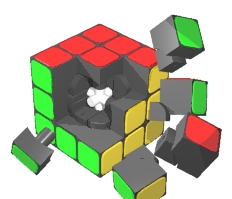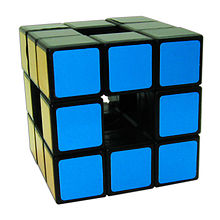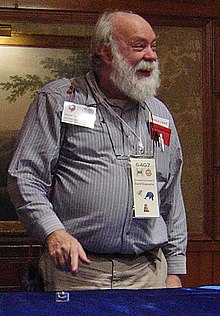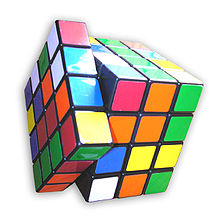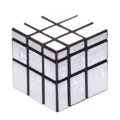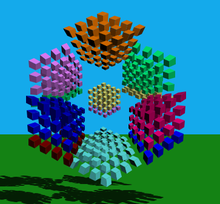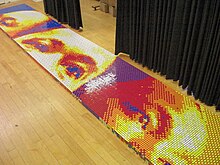Rubik's Cube
The Rubik's Cube is a three-dimensional mechanical puzzle created by the Hungarian sculptor and professor of architecture Ernő Rubik in 1974. Originally called a magic cube”, the puzzle was licensed by Rubik to be sold by the Ideal Toy Company in 1980, the year in which it won the German Game of the Year award in the best puzzle category. As of 2020, 450 million cubes have been sold worldwide, making it not only the best-selling puzzle, but generally considered the best-selling toy in the world.
A classic Rubik's Cube has six uniform colors (traditionally white, red, blue, orange, green, and yellow). An axis mechanism allows each face to rotate independently, thus mixing the colors. To solve the puzzle, each face must return to a single color.
The cube celebrated its 25th anniversary in 2005, so a special edition of the cube was released in which the white face was replaced by a reflective one reading "Rubik's Cube 1980" -2005». On its 30th anniversary, in 2010, another special edition made of wood was released.
There are variations with various numbers of levels. The main versions that exist are the following: the 3×3×3, the original Rubik's cube, the 4×4×4 (Rubik's Revenge), the 5×5×5 (The Professor's Cube); and since September 2008 the 6×6×6 and 7×7×7 by Verdes Panagiotis. The Shengshou company has launched 8x8x8, 9x9x9 and 10x10x10 cubes on the market since the beginning of 2012. Since then, both new products and new brands have come out.
Conception and development
Previous attempts
In March 1970, Larry Nichols invented a puzzle with rotatable pieces in 2×2×2 groups and filed for a Canadian patent. Nichols' toy was held on using magnets. Nichols was granted a US patent (3655201) on April 11, 1972, two years before Rubik invented his cube.
On April 9, 1970, Frank Fox patented his spherical 3×3×3. He received a UK patent (1344259) on January 16, 1974. [citation needed]
Rubik's Invention
In the mid-1970s, Ernő Rubik was working in the Department of Interior Design at the Academy of Applied Arts and Crafts in Budapest. Although it is generally said that the cube was built as a school tool to help his students students to understand three-dimensional objects, their real purpose was to solve the structural problem that could move the parts independently without the entire mechanism falling apart. Rubik did not realize he had created a puzzle until the first time he mixed his new cube and tried to return it to the original position. He obtained a Hungarian patent (HU170062) in 1975. Originally, Rubik's cube was called a magic cube (Bűvös kocka) in Hungary. The puzzle had not been internationally patented within one year of the original patent. In this way, the patent law prevented the possibility of patenting it internationally. Ideal Toy Company wanted at least one recognizable name to register; the deal put Rubik in the spotlight as the magic cube was renamed after its inventor.
The first copies of the Rubik's cube went on sale at the end of 1977 in toy stores in Budapest. The magic cube was held together by interlocking plastic pieces that prevented the pieces from coming apart, unlike the magnets in Nichols' design. An agreement was signed with Ideal to sell the magic cube worldwide in September 1979 and the puzzle made its international debut at toy fairs in London, Paris, Nuremberg and New York in January and February 1980.
After the international success of the Rubik's Cube in Western toy stores it was halted briefly so that the toy could meet Western standards for safety and packaging. A lighter cube was produced and Ideal Toys decided to rename it; the "Gordian Knot" and "Inca Gold" were considered, but the company ultimately settled on the "Rubik's Cube." The first delivery was exported from Hungary in May 1980. Due to the shortage of the product many cheaper imitations arose.
Patent disputes
Nichols assigned his patent to his employer company, Moleculon Research Corp., which sued the Ideal Toys Company in 1982. In 1984, Ideal lost the patent infringement lawsuit and appealed. In 1986 the appeals court upheld that the 2×2×2 "Pocket Cube" Rubik's cube infringed Nichols' patent, but reversed the judgment on the 3×3×3 Rubik's cube.
Still in the process of applying for a Rubik's patent, Terutoshi Ishigi, a self-taught engineer and owner of a forge near Tokyo, filed for a patent for a virtually identical mechanism and received a patent (JP55-8192) in 1976. Until 1999, when the new Japanese patent law came into effect, Japan's office granted national patents for undisclosed technology within the country without having to be globally novel. Therefore, Ishigi's patent is generally accepted. as a standalone reinvention.
Rubik applied for a second Hungarian patent on October 28, 1980 and applied for other patents. In the United States he was given another on March 19, 1983.
Greek inventor Panagiotis Verdes patented a method for creating cubes beyond 5×5×5 to 11×11×11 in 2003, though he claims he had the original idea around 1985. His designs, which include improved mechanisms for 3×3×3, 4×4×4 and 5×5×5 are appropriate for speedcubing. It was announced that these cubes would be released to the market in September 2008 through the VCube brand.
Mechanism
A standard Rubik's cube measures unassembled 5.7 cm on each side, although there are variations. The puzzle consists of 26 pieces or small cubes. Each includes a hidden internal extension that interlocks with the other cubes, while allowing them to be moved into different positions. However, the center pieces of each of the six faces are simply a square attached to the main mechanism. This provides the structure for the other pieces to fit in and rotate around. Thus there are 21 pieces: a central piece consisting of three axes holding the six center squares in place but allowing them to rotate, and 20 plastic pieces that fit on it to form the assembled puzzle.
Each of the six centers rotates on a screw (clamp) gripped by the center piece. A spring between each screw head and its corresponding part stresses the part inward, so the assembly remains compact, but can still be easily manipulated. The screw can be tightened or loosened to change the tension of the hub. Newer official brand hubs have rivets instead of screws, making it impossible to adjust.
The cube can be taken apart without too much difficulty, usually by rotating the top layer about 45° and prying off an edge piece. So this is a simple "solve" the cube, disassemble it and reassemble it in a resolved state.
There are six center pieces that show a single colored face, twelve edge pieces that show two colored faces, and eight corner pieces that show three colored faces. Each piece displays a unique combination of colors, but not all combinations are present (for example, if red and orange are opposite sides of a solved cube, there will not be a red-orange edge piece). The relative location of those cubes with respect to each other can be altered by rotating the outer third or side of the cube 90°, 180° or 270°, but the relative location of the color of the sides with respect to each other cannot be changed: it is determined by the relative position of the central squares.
Douglas Hofstadter, in the July 1982 issue of Scientific American, pointed out that cubes could be colored in such a way as to emphasize edges or vertices, rather than faces, like the standard coloring does; but neither of these alternate colorings caught on.
Math
Permutations
The original Rubik cube (3×3×3) has eight vertices and twelve edges a normal cube. There. 8!{displaystyle 8!,!} (40 320) ways to combine cube vertices. Seven of these can be guided independently and the orientation of the eighth will depend on the previous seven, giving 37{displaystyle 3^{7},!} (2187) possibilities. In turn there is 12!/2{displaystyle 12!,/2} (239 500 800) ways to dispose of the edges, since a parity of the corners also implies a parity of the edges. Eleven edges can be turned independently and the rotation of the twelfth will depend on the previous ones, giving 211{displaystyle 2^{11},!} (2048) possibilities. In total the number of possible permutations in the Rubik cube is:
8!⋅ ⋅ 12!⋅ ⋅ 37⋅ ⋅ 2112{displaystyle {8}cdot 12!cdot 3^{7}cdot 2^{11}} over 2} = 43 252 003 274 489 856 000
That is, forty-three trillion two hundred fifty-two thousand three trillion two hundred seventy-four thousand four hundred eighty-nine million eight hundred fifty-six thousand permutations.
Central faces
The original Rubik's cube had no markings on the center faces (although some had the words "Rubik's cube" in the center square of the white face), and therefore did not require paying attention to the problem. correctly orient said central faces. However, some cubes have been commercially produced with all-centre markings, such as the cuboku. Theoretically, a cube can be solved by having the centers rotated; but it becomes an additional challenge to also solve the centers.
Marking the centers of the Rubik's cube increases its difficulty because it expands the set of possible distinguishable configurations. There are 46/2 (2048) ways to orient the centers, since a parity of the vertices implies an even number of simple moves of the centers.
In particular, when the cube is solved, apart from the orientations of the center faces, there will always be an even number of center faces that require a 90º turn. The orientations of the centers increase the total number of possible permutations of the cube by 43 252 003 274 489 856 000 (4.3 × 1019) to 88 580 102 706 155 225 088 000 (8.9 × 1022).
Rotating a cube around its own axis is considered a permutation change, since it involves counting the positions of the center faces. In theory, there are 6! ways to arrange the six central faces of the cube, but only 24 of these are possible without having to disassemble the cube. When the orientations of the centers are also counted, the total permutations increase from 88 580 102 706 155 225 088 000 (8.9 × 1022) to 2 125 922 464 947 725 402 112 000 (2.1 × 1024).
Group Theory
Let P be the set of permutations of the Rubik's cube. We can define the operation "followed by", denoted by →, as
→: P × P → P
such that a → b:= b ∘ a:
that is, a → b is the result of first executing a and then b.
We will call sequence or algorithm any expression of the form a1 → a2 →... →an, where a1, a2,... an are turns.
Claim: (P, →) is a group.
Demo:
- Closure: a,b certifiedP, it is easy to see quer a.b certifiedP, given that they are allowed spins.
- Associative: (a → b) → c = c) (b) a) = (c) b)) a = a → (b → c).
- Neutral element: trivial permutation, which we will denote ∅ ∅ {displaystyle emptyset }which corresponds to not making any turn, that is, P → ∅ ∅ {displaystyle emptyset } = ∅ ∅ {displaystyle emptyset } → P = P.
- Inverse: Each permutation has reversed. Indeed, yes P = a1 → a2 →... →an It's a sequence and we define Q = an-1 →...2-1 →a1-1Trivially checks P → Q = Q → P = ∅ ∅ {displaystyle emptyset }.
Algorithms
In the terminology of Rubik's cube aficionados, a memorized sequence of moves that has a desired effect on the cube is called an algorithm. This terminology derives from the mathematical use of algorithm, a prewritten set of instructions or well-defined, ordered and finite rules that allows an activity to be carried out in successive steps. Each method of solving the cube employs its own set of algorithms, along with descriptions of what the effect of the algorithm is and when it can be used to bring the cube closer to being solved.
Many algorithms are designed to transform only a small part of the cube without disassembling other parts already solved and thus can be applied repeatedly to different parts of the cube until it is solved. For example, there are algorithms to swap three vertices or change the orientation of two vertices without changing the rest of the puzzle.
Some algorithms have a desired effect on the cube (for example, swapping two vertices) but may have side effects (such as swapping two edges). Such algorithms are often simpler than others with no unwanted effects and are most commonly used early on, when most of the puzzle has not been solved and side effects are not important. Towards the end of the solution, more specific (and usually more complex) algorithms are used to avoid mixing up parts of the cube that have already been solved.
Solutions
Notation
Most Rubik's cube aficionados use a notation developed by David Singmaster to encode a sequence of moves, called "Singmaster notation". Its relative nature allows the algorithms to be written in such a way that they can be applied independently which side is designated superior or how the colors are arranged in a particular cube, the letters come from the name of their position in English, ie “F” comes from front, “B” from back, etc.
- ' ▪ anti-horn movement
- 1 R (right) the side directly to the right of the front.
- 2 L' (left): the side directly to the left of the front.
- 3 /2005 U' (above): the side above or at the top of the front side.
- 4 D (below): the opposite side to the top, under the cube.
- 5 F (front): the side opposite the person.
- 6 /2005 B' (back): the opposite side to the front.
- 7 ▪ R' (right): the side directly to the right of the front.
- 8 ▪ L (left): the side directly to the left of the front.
- 9 ▪ U (top): the side above or at the top of the front side.
- 10 ▪ D' (below): the opposite side to the top, under the cube.
- 11 ▪ F' (front): the side opposite the person.
- 12 ▪ B (back): the opposite side to the front.
- 13 M (medium): the layer of the medium which is equal to moving L and R at the same time
- 14 /2005 M2 (average): duplo
- 15:6 R2 (right):
- 16:6 L2 (left):
- 16 ▪ U2 (both):
- 1/ D2 (below):
- 17 ▪ F2(front): Duplo
- 18 ▪ B2 (behind):
- f (two front layers): the side opposite the person and the corresponding middle layer.
- b (two layers back): the opposite side to the front and the corresponding middle layer.
- u (two layers above): the upper side and the corresponding medium layer.
- d (two layers below): the lower side and the corresponding medium layer.
- l (two left layers): the side to the left of the front and the corresponding middle layer.
- r (two right layers): the right side of the front and the corresponding middle layer.
- x (rotate on axle x): rotate the entire cube in R.
- and (rotate on the shaft and): rotate the entire cube in U.
- z (rotate on the z axis): rotate the entire cube in F.
When a letter is followed by a prime, it indicates counterclockwise movement, while a letter without a prime indicates clockwise movement. A letter followed by a 2 (occasionally superscript, 2) indicates two turns, or a 180º turn.
For methods using mid-layer turns (particularly the vertex-first method, developed by Ernő Rubik) an extension of the notation called "MES" is generally accepted, where the letters M, E and S indicate movements of middle layers. It is used, for example, in Marc Waterman's algorithms.
- M (medium): vertical inner layer in "l" sense.
- E (equator): horizontal inner layer with the "u" direction.
- S (position): upper inner layer (central) moved in sense "f".
The 4×4×4 cube and other larger cubes use an extended notation to refer to the additional layers in between. In general, the capital letters (F B U D L R) refer to the outer parts of the cube (called faces). The lowercase letters (f b u d l r) refer to inner parts of the cube (called slices). An asterisk (L*), a number in front of the letter (2L), or two layers in parentheses (Ll), mean turning two layers at the same time (both the inner and outer left faces).
Optimal Solutions
Although there are a significant number of possible permutations for the Rubik's cube, a number of solutions have been developed that allow the cube to be solved in 20 moves.
Many solutions to the Rubik's Cube have been discovered independently. The most popular method was developed by David Singmaster and published in the book Notes on Rubik's "Magic Cube" in 1981. This solution consists of solving the cube layer by layer: the one called top is resolved first, followed by the middle one, and lastly the bottom one. After some practice it is possible to solve the cube in less than a minute. Other methods are, for example, "corners first" and methods that combine several methods.
Quick fixes have been developed to solve the cube as efficiently as possible. The most common quick fix was popularized by Jessica Fridrich. It is similar to the layer-by-layer method, but uses more algorithms, especially for orienting and permuting the last layer. The four edges of the first layer (the cross) are resolved first, followed by the vertices of the first layer and the edges of the second layer resolved simultaneously (F2L). The last layer (OLL and PLL, respectively) is then oriented and swapped. Fridrich's solution requires learning about 120 algorithms but allows the cube to be solved in only 56 average moves. To facilitate its learning, a reduction of the method is usually learned first, it consists of little more than 10 algorithms. Another well-known solution was developed by Lars Petrus. In that method a 2×2×2 section is solved first, followed by a 2×2×3 section, and then the incorrectly placed edges are solved using a three-move algorithm which eliminates the need for a possible 32-move algorithm.. The principle of this method is to eliminate the disadvantage of layer-by-layer methods of constantly having to take apart and reassemble the first layer; the 2×2×2 and 2×2×3 sections allow multiple sides to be rotated without ruining other developments. One of the advantages of this method is that it tends to give solutions in fewer moves, for that reason, the method is popular for number of moves competitions.
In 1997 Denny Dedmore published a solution using schematic icons to represent the moves that need to be made, instead of the usual notation.
Philip Marshall's Definitive Solution to the Rubik's Cube is a modified version of Fridrich's method that uses 65 average spins but requires the memorization of only 2 algorithms.
A different type of solution is the one developed by Ryan Heise, which does not use algorithms, but a set of fundamental principles that can be used to solve the cube in less than 40 moves.
In 1982 David Singmaster and Alexander Frey hypothesized that the number of moves required to solve a Rubik's cube, given an ideal algorithm, could be "in the lower twenty". In 2007, Daniel Kunkle and Gene Cooperman used a supercomputer to show that any 3×3×3 cube could be solved in a maximum of 26 moves. Between March and August 2008, Tomas Rokicki lowered the maximum to 25, 23, and finally 22 moves. In July 2010 a group of researchers, including Rokicki, working with Google, demonstrated that the so-called "God's number" was 20. For example, the position known as the "superflip" (U R2 F B R B2 R U2 L B2 R U' D' R2 F R' L B2 U2 F2), where each edge is in its correct position but wrongly oriented, requires 20 moves to solve. It was the first to be found to require 20 moves. More generally, a Rubik's cube has been shown to n × n × n can be optimally solved in Θ(n2 / log(n)) moves.
Competitions and records
Speedcubing Competitions
Speedcubing (or speedsolving) is the practice of trying to solve a Rubik's cube in the shortest possible time. There are a number of speedcubing competitions throughout the world.
The first world tournament was organized by the Guinness Book of World Records and was held in Munich on March 13, 1981. All the cubes were rotated 40 times and lubricated with Vaseline. The official winner, with a time of 38 seconds, was Jury Froeschl, born in Munich.
The first international world tournament was held in Budapest on June 5, 1982 and was won by Mihn Thai, a Vietnamese student from Los Angeles, with a time of 22.95 seconds. Since 2003 the competitions are determined by the average time (of 5 attempts); but the best single time of all is also recorded by the World Cube Association (WCA), which maintains the record of world records. In 2004 the WCA made it mandatory to use a special device called the Stackmat Chronometer.
The championships sponsored by the World Cube Association include various modes of solving the Rubik's cube, including:
- Solve it with blindfolded eyes. Timeline includes inspection and resolution.
- Solve it with one hand.
- Solve it in the least amount of movements.
Also, there are other categories where variations of the Rubik's cube are solved.
In addition to official competitions, there are alternative modalities not recognized by regulatory bodies, such as:
- Solve it one person with blindfolded eyes and another telling him what turns to do, known as Blindfolded team.
- Solve the bucket under water in one breath.
Plus brands
These are the world international records of modalities related to the Rubik's cube approved by the World Cube Association.
Yusheng Du holds the current world record for 3x3x3 single solve with a time of 3.47 seconds.
On March 17, 2012, 134 students at Dr Challoner's Grammar School in Amersham, England broke the previous Guinness record for the most people solving Rubik's cubes at the same time in 12 minutes. The previous one was made in December 2008 in Santa Ana, California, obtaining 96 resolutions.
On February 5, 2016, the American Jay Flatland presented an Arduino-controlled robot, capable of solving the cube in less than a second.
On May 25, 2003, the Mexican Martín Telésforo, known as El Feo, broke the world record with 4.41 but, in the end, the tournament was not made official due to mismatches in the direction his mark was never registered. Internet users accused him of cheating and he had to quit Speedcubing forever. This changed Speedcubing forever.
Variations
There are different variations of the Rubik's cube, which go up to thirteen layers: the 2×2×2, 3×3×3 cube, the 4×4×4, 5×5×5, 6× cube 6×6 (V-Cube 6), 7×7×7 (V-Cube 7), 8x8x8 (Shengshou 8x8), 9x9x9 (Shengshou 9x9), 10x10x10 (Shengshou 10x10), 11x11x11 (YuXin 11x11), and 13×13×13 (Moyu 13x13). However, there are larger cubes that have not come onto the market, for example, the one designed by Oskar van Deventer, with seventeen layers, presented at the New York Symposium on February 12, 2011,[citation needed] or the 22×22×22 one from corenpuzzle.
CESailor Tech's E-cube is an electronic variant of the 3×3×3 cube, made of RGB LEDs and switches. There are two switches on each row and column. Pressing a switch indicates the direction of rotation, which causes the LED display to change colors, simulating real rotations. The product was displayed at the Taiwan government university design show on October 30, 2008.
Another electronic variation of the 3×3×3 Cube is the TouchCube. Sliding a finger over their faces causes their colored light patterns to rotate in the same way a mechanical cube would. The TouchCube was introduced at the International American Toy Fair in New York on February 15, 2009.
Among the cubic variations stands out the "Magic Cube", which is mechanically identical to the original, but uses colored numbers on its faces in such a way that the only way to solve it is for all the numbers to match. right on the same face; additionally the numbers of the faces form magic squares, which can all have the same constant. A very similar cube is the cuboku in which the objective is to form sudoku puzzles with the numbers on the faces. Or a cube cut not parallel to the faces: the Skewb. Others include placing images instead of colors or color patterns that confuse the solver, such as placing four different colors on each side of a 4×4×4 for a total of 24 different colors or reducing the number of colors to 3.
One of its most curious variations is the Oskar Treasure chest, created by Oskar Van Deventer and later mass-produced by Meffert. The feature that makes this modification unique is that it allows, once resolved, to extract its upper layer (usually white), inside it is hollow, making it possible to hide objects the size of a golf ball.
The cube has inspired a whole category of similar puzzles, including cubes of different sizes as well as different geometric shapes. Some of these shapes are the tetrahedron (Pyraminx and its variant, Pyramorphix), the octahedron (Skewb diamond), the dodecahedron (Megaminx), the icosahedron (Dogic and Impossiball, spherical icosahedron). There are also shape-shifting puzzles, such as the Rubik's Snake and the Square One, used in official competitions. Ernő Rubik has created other puzzles that differ quite a bit from the cube design but are named after it, such as Rubik 360, Rubik's clock, Rubik's magic and its variant Rubik's magic: master edition. These last three were also used in official competitions.
In turn, various cuboids have been created, puzzles based on the Rubik's cube but with different dimensions, such as the 1×1×2 (Boob cube), the 3×3×1 (Floppy cube), the 2 ×2×4, 2×3×4, 3×3×5...
New variants of the original cube are continually appearing; one of the most original is the 3x3 DNA cube. The peculiarity of this cube is that it is hollow, with different geometric shapes on each of its faces, there being the classic and concave version.
During the cube heyday, video game company Atari released its cartridges for the Atari 2600 console called "Rubik's Cube" (CX2698), "Atari Video Cube" (reissue renamed for copyright reasons, CX2670) and the "Rubik's Cube 3D" that did not go on the market.
Extra-dimensional variations
In 1994 Melinda Green, Don Hatch, and Jay Berkenilt created the so-called MagicCube4D, which is a four-dimensional model of the Rubik's Cube in Java consisting of hypercubes from 2×2×2×2 to 5×5× 5×5. With many more possible states such an object is much more difficult to solve. So far only 78 people have managed to solve it. The geometric shape of this cube is a tesseract, with each line divided into 3 equal parts for the standard puzzle; The result of this is that in addition to the pieces of 1, 2, and 3 colors of the 3-dimensional cube, there is a fourth type of piece with 4 colors each at the vertices.
In 2006 Roice Nelson and Charlie Nevill created the five-dimensional Magic Cube 5D model from 2×2×2×2×2 to 5×5×5×5×5 which has so far been solved by only twelve people. In this puzzle there are also pieces with five colors on the vertices.
NXN Classics
In this family are all those cubic puzzles such as 3×3, that is, those in which n=x. The NXN family includes all the cubes with the same number of faces, from 1×1 to the already invented (by mass) 22×22, although not all of them have been currently manufactured.
Minx pyramids
This family includes some pyramid-shaped puzzles with 4 faces that rotate 120 degrees each. For example: the Pyraminx, the Master Pyraminx, the Professor Pyraminx, the Royal Pyraminx and the Emperor Pyraminx
Other face turning type cubes are also included, such as the octahedron face turning, the icosaix, the nebula or the face icosahedron despite not be pyramids.
Minx dodecahedrons
This family includes various dodecahedron-shaped cubes such as the famous Megaminx, as well as the Gigaminx, Teraminx, Petaminx, Examinx, Zettaminx and the Yottaminx, which is the largest dodecahedron in the world.
Other examples could be Kilominx, Flowerminx, Bahuina, Helicopter Dodecahedron, Starminx in all its versions, Connerminx and Conermate.
Also variations of the 2×2 and 3×3 made dodecahedron.
The Tuttminx and Rayminx cubes are truncated icosahedrons but are included in this group because of their type of solution similar to that of dodecahedrons.
In popular culture
Rubik's Cube fascinated people around the world and became one of the most popular games in America by the mid-1970s. In just seven years worldwide sales had exceeded thirty million units; a well-known buyer at the FAO Scwarz toy emporium in New York noted that it had become "the most sought-after toy". Some even argued that it could lead to obsessive behaviour. Pirated editions appeared in Taiwan, Hong Kong and some American cities. The cube spawned a television series and literary works. As of January 2009, 350 million cubes have been sold worldwide, making it the world's best-selling puzzle game. The cube earned a place as a permanent exhibit at the Museum of Modern Art in New York and was entered into the Oxford English Dictionary after just two years. It maintains a dedicated following, with nearly 40,000 YouTube entries offering tutorials and videos. of solutions.
Gadgets and electronic versions
In 2018, the 13-year-old inventor with his father, from Novato, United States, introduced the 2x2x2 version of the Rubik's cube: WOWCube, with 24 screens and several games, which works like a game console.
Art
Alamo (The Astor Cube) is a revolving sculpture designed by Tony Rosenthal located in New York City. In June 2003 it was covered in colored panels that made it look like a Rubik's cube. Similarly, students at the University of Michigan created a giant Rubik's cube and placed it on Central Campus for Memorial Day. the pranks of April 2008. Together, a group of students built another non-functional cube with more than 720 kilos of steel for the North Campus of said university. Removed later that semester, the cube reappeared in September 2008 the first day of classes. Although it was withdrawn again, the university is planning a permanent Rubik's cube art installation on North Campus. The 1980s area of Disney's Pop Century Resort includes a giant Rubik's cube sculpture complete with stairs.
Several artists have developed a pointillist style using Rubik's cubes. This art, also known as Rubik's Cubism, uses standard rubik's cubes. The first recorded work of art was created by Fred Holly, a 60-year-old blind man, in the mid-1980s. These works focused on color and geometric patterns. Street artist "Space Invader" began exhibiting Pointillist works, including one of a man behind a desk and another by Mario Bros, using Rubik's cubes in June 2005 at an exhibition called "Rubik Cubism" at Sixspace, Los Angeles. Prior to that exhibition the artist had used Rubik's cubes to create a giant Space Invaders. Another similar artist is Robbie Mackinnon of Toronto, Canada, whose early work was published in 2007, who claims to have developed his cubist pointillism years ago, while he was a teacher in China. Robbie Mackinnon's work has been featured in "Believe it or Not" by Ripley and focuses on the use of pop-art, while Space Invader has exhibited his "Cube Art" next to the Space Invaders mosaic in public and commercial galleries.
In 2010 Pete Fecteau created Dream Big, a tribute to Martin Luther King Jr. using 4,242 official Rubik's cubes. Fecteau is also working with the organization You Can Do The Rubik's Cube to create two guides to teach school-age children how to create mosaics with Rubik's cubes from templates he makes himself.
Contenido relacionado
History of the comic in Spain
Gabriel Vargas (artist)
Heraldry


